You might be a librarian if…
you walk into a book store to buy your next book club read and spend an hour reading almost all of the picture books that you’ve put in requests for at the library (I say almost, because that number may be 22) because you just can’t wait.
you take pictures of the covers of all of the ones you “must” add to your library this year.
you build a list with a brief description and picture to give teachers as a welcome back treat.
you love to share great books so you also post the list on your newly created blog!
A brief aside: I’ve decided to make this a weekly (or monthly) resource for my teachers, so I’ve only put 10 on this list for now, but be on the lookout for a new batch of 10 each week (or month)!
And now here it is, ten books that can help foster a sense of emotional intelligence, kindness, and empathy within your classroom:
What Do You Do With a Problem?
Written by: Kobi Yamada Illustrated by: Mae Besom
 A boy sees a problem and tries to ignore it, but that only makes it worse and bigger. The story follows his journey as he tries to finally overcome it. Whimsical illustrations and a relatable message make this a great read aloud about overcoming any problems students may face. Pairs well with What Do You Do With a Chance? and What Do You Do With an Idea? by the same author/illustrator.
A boy sees a problem and tries to ignore it, but that only makes it worse and bigger. The story follows his journey as he tries to finally overcome it. Whimsical illustrations and a relatable message make this a great read aloud about overcoming any problems students may face. Pairs well with What Do You Do With a Chance? and What Do You Do With an Idea? by the same author/illustrator.
What If…
Written by: Samantha Berger Illustrated by: Mike Curato
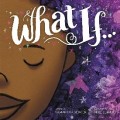 A creative girl continually comes up with a way to keep creating “if” each of her tools (pens/paints, paper, desk, walls, etc) were to disappear. Beautiful illustrations culminate in a double fold-open page depicting all of her ideas. A great message of resiliency and focusing on what you can do, instead of what you can’t.
A creative girl continually comes up with a way to keep creating “if” each of her tools (pens/paints, paper, desk, walls, etc) were to disappear. Beautiful illustrations culminate in a double fold-open page depicting all of her ideas. A great message of resiliency and focusing on what you can do, instead of what you can’t.
I’m Sad
Written by: Michael Ian Black Illustrated by: Debbie Ridpath Ohi
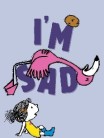 Flamingo is sad, so his friends (a Potato and a Girl) try to cheer him up! They tell him all about what makes them feel better when they are sad, but it doesn’t help – Flamingo is still sad. Luckily, Flamingo is able to learn that his sadness won’t last forever and his friends learn that sometimes just being a good friend doesn’t mean you always have the answers. Even if friends can make you laugh and feel a little better, sometimes it’s ok to just feel sad. Pairs well with I’m Bored by the same author/illustrator.
Flamingo is sad, so his friends (a Potato and a Girl) try to cheer him up! They tell him all about what makes them feel better when they are sad, but it doesn’t help – Flamingo is still sad. Luckily, Flamingo is able to learn that his sadness won’t last forever and his friends learn that sometimes just being a good friend doesn’t mean you always have the answers. Even if friends can make you laugh and feel a little better, sometimes it’s ok to just feel sad. Pairs well with I’m Bored by the same author/illustrator.
Adrian Simcox Does Not Have a Horse
Written by: Marcy Campbell Illustrated by: Corinna Luyken
 Adrian Simcox loves telling anyone who will listen about his beautiful horse, but classmate Chloe is convinced that he is lying and is sick of his tales. She continuously tells her classmates, and her mom, that he’s lying every time he starts elaborating on his beautiful mare. Ultimately, Chloe is able to discover empathy as her mom coaxes her to walk their dog and leads them into Adrian’s neighborhood. Here, she realizes that his stories of a magical horse are one of the few things he does have and she is able to see it’s beauty too. A great story to remind students to not judge others and the importance of kindness.
Adrian Simcox loves telling anyone who will listen about his beautiful horse, but classmate Chloe is convinced that he is lying and is sick of his tales. She continuously tells her classmates, and her mom, that he’s lying every time he starts elaborating on his beautiful mare. Ultimately, Chloe is able to discover empathy as her mom coaxes her to walk their dog and leads them into Adrian’s neighborhood. Here, she realizes that his stories of a magical horse are one of the few things he does have and she is able to see it’s beauty too. A great story to remind students to not judge others and the importance of kindness.
Allie All Along
Written and Illustrated by: Sarah Lynne Reul
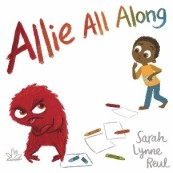 This story follows the transformation of Allie as she gets angry over a broken crayon, which immediately turns her into a red monster. Her brother offers her support in many forms, such as squeezing a stuffed animal or breathing techniques, to help her and she is able to shed the red, revealing continuous other ‘monsters’ that match the colors of the zones of regulation, as she makes it all the way back to herself. Having Allie ultimately reveal her real self at the end by unzipping each costume is a clever way to illustrate to students that when they’re experiencing different negative emotions, they haven’t lost themselves, they just need to find a way to get rid of the emotions that are trying to control them.
This story follows the transformation of Allie as she gets angry over a broken crayon, which immediately turns her into a red monster. Her brother offers her support in many forms, such as squeezing a stuffed animal or breathing techniques, to help her and she is able to shed the red, revealing continuous other ‘monsters’ that match the colors of the zones of regulation, as she makes it all the way back to herself. Having Allie ultimately reveal her real self at the end by unzipping each costume is a clever way to illustrate to students that when they’re experiencing different negative emotions, they haven’t lost themselves, they just need to find a way to get rid of the emotions that are trying to control them.
After the Fall
Written and Illustrated by Dan Santat
 What happened to Humpty Dumpty after he fell off the wall? According to this story, he became afraid of falling again, so he became extra careful, certainly avoiding any heights so that he wouldn’t fall again. But what will he do when a bird he created flew over a wall? Exactly what we hope all of our students can do– he faced his fears and gathered the courage to climb up over the wall to get it back. A great story to start a discussion with students about resiliency, facing fears, and not judging someone for their mistakes.
What happened to Humpty Dumpty after he fell off the wall? According to this story, he became afraid of falling again, so he became extra careful, certainly avoiding any heights so that he wouldn’t fall again. But what will he do when a bird he created flew over a wall? Exactly what we hope all of our students can do– he faced his fears and gathered the courage to climb up over the wall to get it back. A great story to start a discussion with students about resiliency, facing fears, and not judging someone for their mistakes.
Sarabella’s Thinking Cap
Written and Illustrated by: Judy Schachner
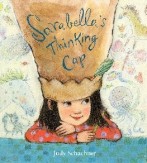 Sarabella is constantly living in her imagination, much to the chagrin of her teacher who frequently reminds her there’s a time for daydreams and a time to focus through notes home. As she keeps trying, but failing, to get better at school, her teacher provides an assignment that’s perfect for her and through it, Sarabella finds a way to let all of her classmates into the imaginative adventures playing in her head. The pages are covered with gorgeous dream-like illustrations of Sarabella’s daydreams as readers are reminded that not everyone is the same and we each have our own, unique, gifts.
Sarabella is constantly living in her imagination, much to the chagrin of her teacher who frequently reminds her there’s a time for daydreams and a time to focus through notes home. As she keeps trying, but failing, to get better at school, her teacher provides an assignment that’s perfect for her and through it, Sarabella finds a way to let all of her classmates into the imaginative adventures playing in her head. The pages are covered with gorgeous dream-like illustrations of Sarabella’s daydreams as readers are reminded that not everyone is the same and we each have our own, unique, gifts.
How To Be a Lion
Written and Illustrated by: Ed Vere
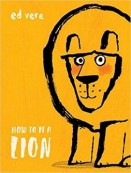 Bold colors and unique illustrations follow a pack of lions who are told to be fierce and strong while one of their own, Leonard, finds his own gentler path. Leonard becomes friends with a duck named Marianne and their days are filled with talking, writing poems, and making wishes, until a pride finds them and wants to eat Marianne. Leonard stands up for Marianne and shows readers that loyalty, courage, and kindness can overcome bullying and anger.
Bold colors and unique illustrations follow a pack of lions who are told to be fierce and strong while one of their own, Leonard, finds his own gentler path. Leonard becomes friends with a duck named Marianne and their days are filled with talking, writing poems, and making wishes, until a pride finds them and wants to eat Marianne. Leonard stands up for Marianne and shows readers that loyalty, courage, and kindness can overcome bullying and anger.
Be Kind
Written by: Pat Zietlow Miller Illustrated by: Jen Hill
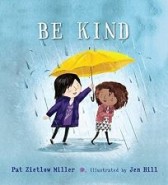 This story begins when Tanisha spills grape juice all over her dress. The narrator, a young girl, has always been told by her mom to be kind so she tries to follow that advice when she sees how distressed Tanisha is. Unfortunately, the girl’s confession that “purple is [her] favorite color”, only makes Tanisha dash from the cafe, not feel any better. What follows is a beautiful contemplation of what kindness actually means, and how far a simple act of kindness may reach, leading to the girl’s understanding that maybe being kind in this situation is just sitting next to Tanisha in art class. A great way to help students reflect on what it means to be kind, and all of the multitude of ways they can show it to others.
This story begins when Tanisha spills grape juice all over her dress. The narrator, a young girl, has always been told by her mom to be kind so she tries to follow that advice when she sees how distressed Tanisha is. Unfortunately, the girl’s confession that “purple is [her] favorite color”, only makes Tanisha dash from the cafe, not feel any better. What follows is a beautiful contemplation of what kindness actually means, and how far a simple act of kindness may reach, leading to the girl’s understanding that maybe being kind in this situation is just sitting next to Tanisha in art class. A great way to help students reflect on what it means to be kind, and all of the multitude of ways they can show it to others.
We Don’t Eat Our Classmates
Written and Illustrated by: Ryan T. Higgins
 Penelope Rex is off to her first day of school, but she didn’t realize that her classmates would be children! She immediately eats them, before her teacher lets her know that “we don’t eat our classmates”. After spitting them back out, Penelope has a tough time making friends with them, though it could be because she’s not done trying to eat them. It’s not until her pet fish tries to take a bite out of her, that Penelope understands how she’s made her classmates feel. Keeping this in mind as she returns to the classroom, Penelope eventually begins to fit in and make friends. A clever and humorous way to illustrate that the importance of being a good friend, and understanding how your actions make others feel.
Penelope Rex is off to her first day of school, but she didn’t realize that her classmates would be children! She immediately eats them, before her teacher lets her know that “we don’t eat our classmates”. After spitting them back out, Penelope has a tough time making friends with them, though it could be because she’s not done trying to eat them. It’s not until her pet fish tries to take a bite out of her, that Penelope understands how she’s made her classmates feel. Keeping this in mind as she returns to the classroom, Penelope eventually begins to fit in and make friends. A clever and humorous way to illustrate that the importance of being a good friend, and understanding how your actions make others feel.
I love this list! Can I borrow all of the books please? What about my new favorite- All Are Welcome? Just bought it today!
LikeLike